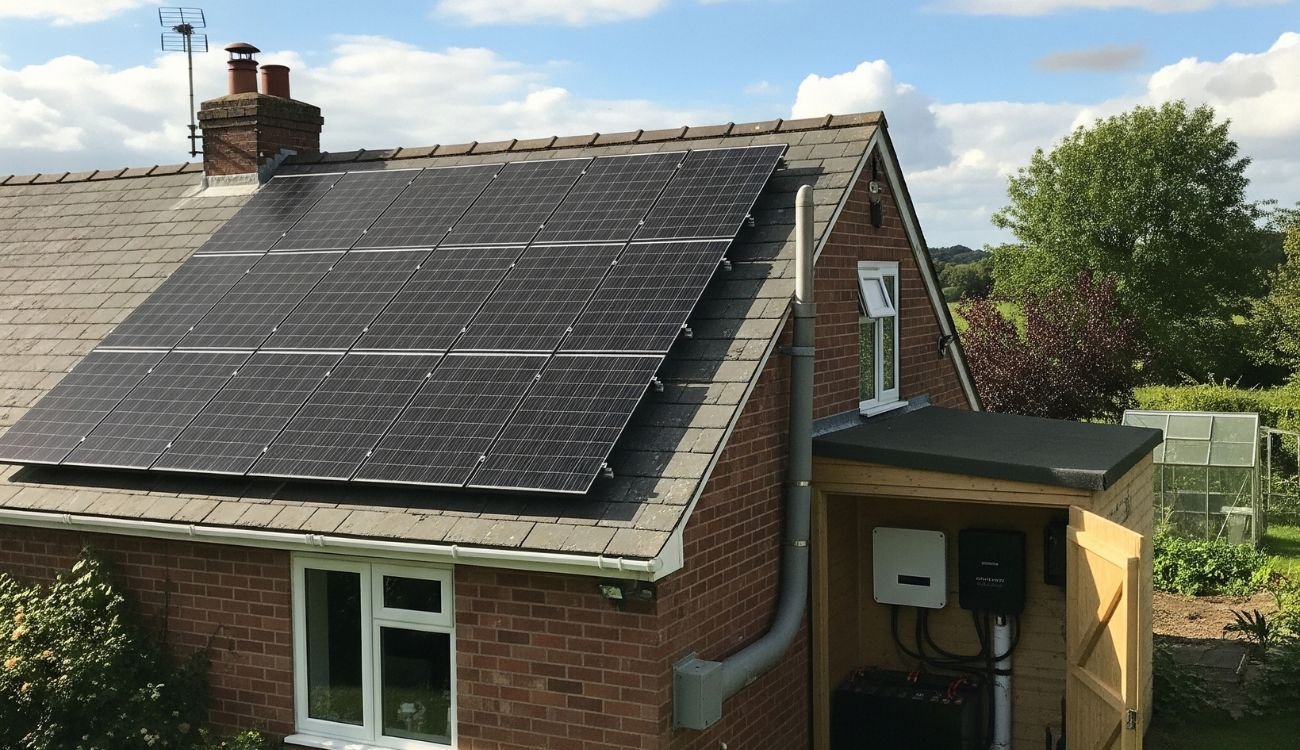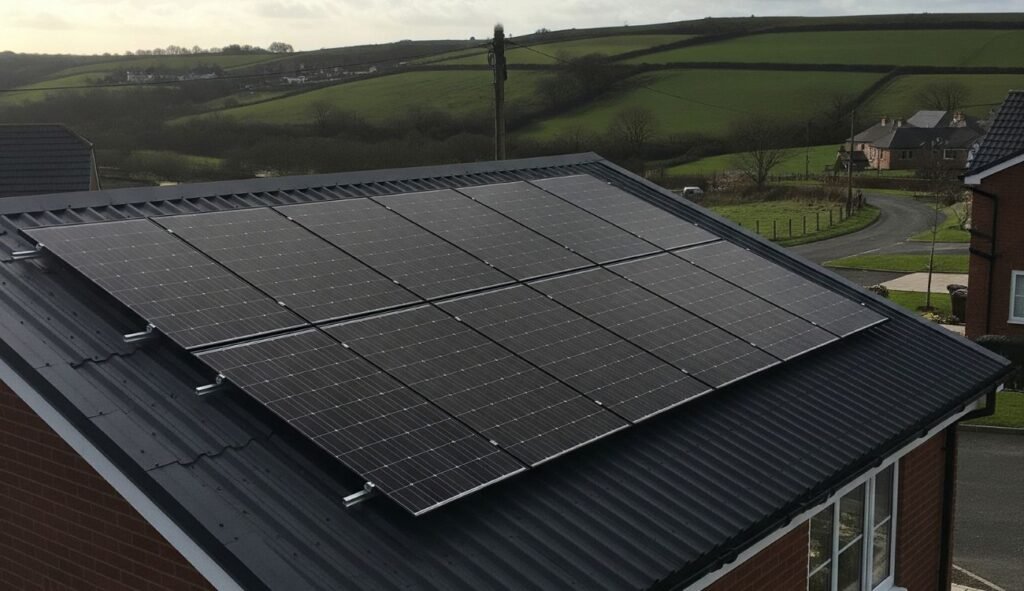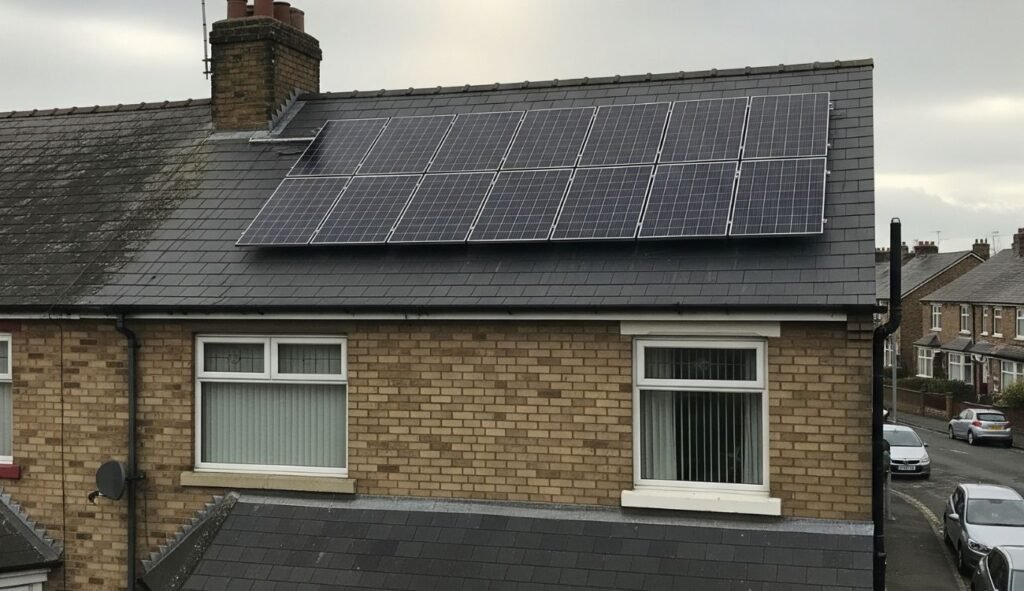Investing in an off-grid solar system is a popular choice for UK homeowners and landlords looking to gain energy independence and reduce electricity bills. But, how much does an off-grid solar system cost?
This guide breaks down all the key factors that influence the price, helping you make an informed decision tailored to your needs and property.
How Much Will You Typically Pay for an Off-Grid Solar System in the UK?
On average, UK homeowners can expect to pay between £7,000 and £20,000 for a complete off-grid solar setup, including solar panels, batteries, inverters, and installation.
However, the exact cost of an off-grid solar system varies widely depending on system size, battery storage, installation complexity, and location.
| System Size (kW) | Estimated Total Cost (£) | Typical Usage |
|---|---|---|
| 2 kW | £7,000 – £9,000 | Small homes, occasional use |
| 4 kW | £10,000 – £13,000 | Average UK home |
| 6 kW | £14,000 – £17,000 | Larger homes or properties with higher usage |
| 8 kW+ | £18,000+ | Larger homes, multiple buildings or high demand |
Note: These prices include solar panels, battery storage, charge controller, inverter, wiring, and installation.
Off-grid solar systems typically cost more than grid-tied systems because they require larger battery banks and more advanced equipment to store power for use during nights or cloudy days.
According to the Energy Saving Trust, investing in the right size system and quality components is crucial to maximise savings and system longevity.
What Can These Off-Grid Solar Systems Power?
- 2 kW systems are suitable for very small properties or secondary buildings with limited electricity needs.
They can power essential lighting, small kitchen appliances, and basic electronics but might struggle with electric heating or large appliances. These systems are ideal for holiday cottages or remote cabins where power use is minimal. - 4 kW systems can comfortably supply an average UK household’s basic needs, including lighting, refrigeration, televisions, computers, and small cooking appliances.
They may support small electric heating or hot water systems during sunny months but might require supplementary heating in winter. - 6 kW systems are designed for larger homes with more occupants or greater electricity demands.
These solar panels systems can handle multiple appliances running simultaneously, including electric showers, washing machines, and possibly electric vehicle charging, especially when combined with sufficient battery storage. - 8 kW+ systems suit homes with very high energy consumption, multiple buildings, or special requirements such as workshops, home offices, or extensive electric heating.
They provide enough power for a fully electric home with electric vehicles and heating throughout the year, relying entirely on solar energy and battery storage.
Investing in the right size system and quality components is crucial to maximise savings and system longevity.
Ensuring your system matches your lifestyle and energy demands helps avoid costly overspending or underpowered setups.
What Factors Influence the Cost of an Off-Grid Solar System?
When considering an off-grid solar system, several key factors influence the overall cost. Understanding these will help you plan effectively and avoid unexpected expenses.
1. System Size and Energy Requirements
The size of your off-grid solar system directly depends on how much electricity your household consumes daily. This is measured in kilowatt-hours (kWh).
A typical UK home uses about 8–10 kWh per day, but this varies widely based on the number of occupants, appliances, heating systems, and lifestyle habits.
- Why does size matter?
The more electricity you use, the more solar panels and battery storage you’ll need to generate and store enough energy. For example, running electric heating, hot water systems, or multiple appliances simultaneously will increase your consumption. - How to estimate your needs:
Reviewing your past electricity bills or using an energy monitor can help estimate your average daily use. Off-grid systems need to be sized generously to account for cloudy days and winter months when sunlight is reduced.
Getting your system size right is critical. An undersized system won’t reliably meet your energy needs, while an oversized system will cost more upfront without necessarily delivering proportional savings.
2. Battery Storage Type and Capacity
In off-grid setups, investing in a solar battery is definitely worth it because they store excess energy generated during sunny hours for use at night or during cloudy weather. The choice of battery significantly impacts both performance and cost.
- Types of batteries:
- Lead-acid batteries: Usually cheaper upfront but heavier, bulkier, and with shorter lifespans (typically 3–7 years). They require regular maintenance like topping up with distilled water.
- Lithium-ion batteries: More expensive initially but more efficient, compact, require less maintenance, and last 10–15 years or longer. They also allow deeper discharges without damaging the battery.
- Capacity matters:
Battery capacity is measured in kilowatt-hours (kWh). A larger capacity means you can store more energy to use when solar production is low, reducing the need to rely on backup generators or other energy sources.
Choosing the right battery type and size ensures you have reliable power when you need it without overspending on storage you don’t require.
How Do Battery Storage Options Impact Off-Grid Solar System Prices?
Below is a comparison of popular battery types:
| Battery Type | Average Cost per kWh (£) | Lifespan (Years) | Efficiency (%) | Typical Use Case |
|---|---|---|---|---|
| Lead-Acid | £100 – £150 | 3 – 7 | 70 – 80 | Budget option, suitable for low usage |
| Lithium-Ion | £300 – £500 | 10 – 15 | 90 – 95 | High efficiency, longer lifespan |
| Saltwater / Flow | £400+ | 15+ | 80 – 90 | Emerging tech, eco-friendly option |
According to Ofgem, investing in reliable, longer-lasting batteries reduces replacement costs and improves system reliability over time.
3. Installation Complexity
Not all homes are equally easy to equip with solar systems. Several factors can increase installation costs:
- Roof type and condition:
Complex roof shapes, steep pitches, or fragile materials may require special mounting equipment or additional safety measures. - Accessibility:
Hard-to-reach roofs or properties with no easy access for installers add to labour time and cost. - Electrical upgrades:
Older properties might need electrical panel upgrades or rewiring to accommodate the new system safely. - Multiple buildings or separate meters:
If you want to power multiple buildings (e.g., a house plus a barn or guest house), extra wiring and equipment will add costs.
Professional installation is vital to ensure your system is safe, compliant with UK regulations, and optimally positioned to capture sunlight.
4. Location and Sunlight Availability
The UK’s weather and geographic location strongly influence solar system sizing and output.
- Sunlight levels vary by region:
The North East of England, including Tyne and Wear and Newcastle, generally receives fewer hours of sunlight and less intense solar radiation than southern parts of the UK. This means your panels may produce less electricity on average. - Seasonal variation:
Winter months can see a significant drop in solar output, which means you may need a larger system or bigger batteries to ensure consistent power throughout the year.
While cold and low sunlight are often top of mind, it’s also worth knowing that hot weather can influence panel performance in its own way. - Impact on cost:
To compensate for lower sunlight, off-grid systems in northern regions often require more solar panels or larger batteries, which increases upfront costs but ensures energy reliability.
Using solar irradiance data and professional site surveys helps tailor the system to local conditions, maximising performance and cost-effectiveness.
5. Additional Equipment and Maintenance
Beyond panels and batteries, several other components add to the total system cost:
- Charge controllers:
These regulate the power flowing from solar panels to batteries, preventing overcharging and prolonging battery life. Quality controllers are essential for system efficiency. - Inverters:
Convert the DC electricity generated by panels and stored in batteries into AC electricity used by household appliances. Off-grid systems often need more sophisticated inverters to manage power supply without grid backup. - Monitoring systems:
Some setups include digital monitoring to track performance and detect faults early, adding to the initial cost but improving system management. - Maintenance costs:
Regular cleaning of panels, battery checks, and occasional component replacements are necessary to keep your system running smoothly and efficiently. While annual maintenance costs are relatively low, budgeting for battery replacement every 7–15 years is important.
Proper maintenance extends the lifespan of your system and ensures you get the best return on your investment.
How Much Does Installation and Maintenance Cost for Off-Grid Solar?
Professional installation is a critical part of setting up your off-grid solar system. It ensures that all components, from solar panels to battery banks and inverters are safely and correctly installed according to UK electrical regulations and industry standards.
- Typical installation costs:
In the UK, installation expenses typically range from £1,000 to £3,000, but this depends on factors such as system size, roof type, accessibility, and electrical upgrades required.
For example, installing on a flat roof or complex roofing structure may increase labour costs. - Why professional installation matters:
DIY installations are not recommended due to the complexity of off-grid systems and safety concerns. A certified installer ensures your system performs optimally and reduces the risk of damage or electrical faults.
Maintenance Costs
Off-grid solar systems generally require minimal maintenance compared to other energy systems, but some regular care is necessary to maintain efficiency and prolong system life.
| Maintenance Task | Frequency | Estimated Cost (£) | Description/Benefits |
|---|---|---|---|
| Annual System Inspection | Once per year | £100 – £200 | Professional check of panels, wiring, batteries, and inverter to detect faults early. Prevents costly repairs. |
| Panel Cleaning | 1–2 times per year | £50 – £150 per visit | Removes dirt, dust, and debris to maximise sunlight absorption and system efficiency. Some homeowners clean panels themselves. |
| Battery Health Checks | Every 1–2 years | £100 – £250 | Tests battery performance and capacity, ensures safe operation, and plans for replacements if necessary. |
| Battery Replacement | Every 7–15 years (depending on battery type) | £3,000 – £7,000+ | Lithium-ion batteries last longer but cost more upfront; lead-acid batteries need replacement more frequently. |
| Inverter Replacement | Every 10–15 years | £1,000 – £2,500 | Inverters may need replacing due to wear or technology upgrades to maintain system efficiency. |
| Miscellaneous Repairs | As needed | Varies | Repairs for wiring, mounting hardware, or other components can arise over time. |
Why Regular Maintenance Matters
Maintaining your off-grid solar system is essential for several reasons:
- Maximise energy production: Clean, well-maintained panels capture more sunlight, improving output.
- Prevent unexpected failures: Early detection of issues in wiring, batteries, or inverters helps avoid costly downtime or emergency repairs.
- Extend equipment lifespan: Routine servicing keeps components in good condition, delaying the need for expensive replacements.
- Safety: Batteries and electrical systems can pose risks if poorly maintained, so professional checks ensure compliance with safety standards.
Regular maintenance and timely battery replacements contribute to system reliability and cost-effectiveness over the long term.
What Is the Return On Investment for an Off-Grid Solar Panel System?
When considering an off-grid solar panel system, understanding the return on investment (ROI) is crucial to determine if the upfront cost is justified by long-term savings and benefits.
Calculating ROI for Off-Grid Solar Systems
The ROI measures how quickly your investment pays for itself through energy savings and other financial benefits.
Unlike grid-tied solar systems, off-grid systems do not generate income through export tariffs or government incentives like the Smart Export Guarantee (SEG).
Instead, savings come primarily from eliminating or significantly reducing your electricity bills and potential costs of alternative power sources (e.g., generators).
Here’s what affects ROI for an off-grid solar system:
- Initial investment costs: Including solar panels, batteries, inverters, and installation.
- Energy cost savings: Money saved by not purchasing electricity from the grid. Off-grid users are fully independent from rising grid energy prices.
- Maintenance costs: Ongoing expenses for system upkeep and battery replacements over time.
- System lifespan: Solar panels typically last 25+ years, while batteries may need replacing after 7–15 years, influencing long-term ROI.
- Energy usage and system size: Higher self-consumption and larger systems increase savings potential.
Typical Payback Periods in the UK
Based on current UK electricity prices and typical energy consumption:
| System Size (kW) | Estimated Cost (£) | Average Annual Savings (£) | Approximate Payback Period (Years) |
|---|---|---|---|
| 2 kW | £7,000 – £9,000 | £500 – £700 | 10 – 15 |
| 4 kW | £10,000 – £13,000 | £900 – £1,200 | 9 – 13 |
| 6 kW | £14,000 – £17,000 | £1,300 – £1,700 | 9 – 12 |
| 8 kW+ | £18,000+ | £1,800+ | 10 or less |
These estimates vary based on individual energy consumption patterns, system efficiency, and regional electricity prices.
Additional Benefits Beyond Direct Savings
- Energy Independence: Avoid vulnerability to grid outages or energy price spikes.
- Increased Property Value: Homes with renewable energy systems often attract higher market value and appeal to eco-conscious buyers or tenants.
- Environmental Impact: Substantially reduce your carbon footprint by relying on clean, renewable energy.
- Off-Grid Freedom: Ideal for remote properties where grid connection is expensive or unavailable.
Important Considerations
- While the payback period for off-grid systems can be longer than grid-tied solar due to battery costs, the non-monetary benefits often justify the investment.
- Choosing high-quality components and ensuring professional installation can improve system longevity and ROI.
- Regular maintenance, especially battery health, plays a crucial role in sustaining your savings.
How Can You Maximise Savings When Investing in Off-Grid Solar?
- Right-sizing your system: Avoid overpaying by carefully calculating your energy needs.
- Choosing high-quality components: Invest in efficient panels and batteries for longevity.
- Consider government grants and incentives: The UK government occasionally offers schemes to support renewable energy adoption.
- Regular maintenance: Keep your system operating at peak performance to maximise returns.
Where Can You Get a Reliable Off-Grid Solar System Installed in the North East?
For homeowners and landlords in Tyne and Wear, Newcastle, and the wider North East, Future Heat is a trusted installer specialising in tailored off-grid solar solutions. Their expert team offers free, no-obligation quotes to help you find the right system at a competitive price.
Request your solar panel quote from Future Heat today to take the first step towards energy independence and lower bills.
FAQs
1. Can I finance an off-grid solar system in the UK?
Yes, many UK companies offer financing options, including loans and payment plans, to spread the upfront cost.
2. Are off-grid solar systems eligible for UK government incentives?
Some off-grid systems may qualify for grants or schemes under specific conditions. It’s best to check the latest information on gov.uk.
3. How long does an off-grid solar system last?
Typically, solar panels last 25+ years. Batteries usually need replacement every 7 to 15 years depending on type and usage.
4. Do I need planning permission for an off-grid solar system?
In most cases, no planning permission is required for domestic solar panels in the UK, but check local council rules to be sure.
5. What maintenance is required for off-grid solar systems?
Basic maintenance includes cleaning panels, inspecting connections, and battery health checks, which a professional installer can assist with.
Our Verdict
Understanding how much an off-grid solar system costs in the UK involves considering multiple factors including system size, battery type, installation, and maintenance.
While upfront costs are higher than grid-tied systems, off-grid solar offers the benefit of complete energy independence, potentially significant long-term savings, and a greener lifestyle.
Homeowners and landlords in Tyne and Wear, Newcastle, and the North East looking to invest should seek expert advice to design a system tailored to their unique energy needs.
Getting a professional quote from specialists like Future Heat ensures you get the best value and quality for your investment.
Myles Robinson is a seasoned expert in the boiler and home improvement industry, with over a decade of experience. He is deeply committed to environmental sustainability, actively promoting energy-efficient heating solutions to help households reduce their carbon footprint. By combining industry expertise with a dedication to environmental responsibility, Myles continues to lead efforts in transforming home heating practices towards a more sustainable future.











